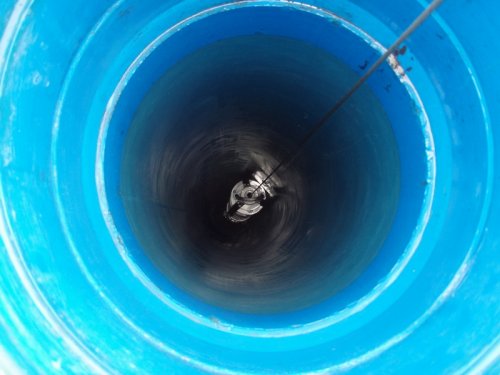
Next summer, at a base in northern Greenland, scientists hope to drill an ice core 2500 deep, all the way down to the bedrock. This base is called NEEM, short for "north Greenland Eemian" — and near the bedrock, they hope to find a 120-meter-thick layer of ice from the Eemian interglacial. This was the warm period right before the last ice age, between 130,000 and 115,000 years ago. During the Eemian, Greenland was between 7 and 8 °C warmer than now, and sea levels were 3-5 meters higher.
This may shed light on our present plight. Right now, Greenland is melting a lot faster than had been expected, thanks in part to streams flowing through cracks in the ice. In Helmheim, on the east coast, the glacier flow has sped up 60% from 2000 to 2005. A bit further north, in Kangerdlugssuaq, it's tripled in speed during that time. Over on the west, it's doubled in speed from 1996 to 2005. The melting of Greenland is now causing sea levels worldwide to rise more than half a millimeter per year. We can expect that rate to keep increasing.
This year's IPCC (International Panel on Climate Change)
report predicts that the sea level will rise
between 18 and 59 centimeters this century. But, they couldn't
provide an upper bound.
Eric Rignot of NASA believes that with the accelerating flow
of glaciers in Greenland and Antarctica, we should expect over
a meter of sea level rise by the century's end.
November 5, 2007
Last Wednesday I spent a night at my folks' house in Great Falls, Virginia.
Then I drove down to Harrisonburg and
gave two talks at James Madison University
in Harrisonburg — one on
global warming and one on
where we stand in
fundamental physics. On Friday I drove back to my folk's place.
It was fun driving from Great Falls to Harrisonburg and back — out from the suburbs, into the countryside, past the Shenandoah River, through the rolling foothills of the ancient, weathered Appalachians, into autumn woodlands. I'd never driven around this part of Virginia on my own, though my parents had taken me to some of these places when I was a kid: Luray Caverns, Skyline Drive...
Besides reminding me of my childhood, the trip reminded me of drives from Boston to Bard College in New York, where Lisa used to teach. Driving west along I66 is like driving west along the Massachusetts Turnpike, out of the city into ever more rural landscapes, with Washington DC replacing Boston. Driving south along highway 81 to James Madison University is like driving south along the Taconic to Bard. The same themes transposed to a southern key! It was like one of those dreams where you find a door you'd somehow never noticed, open it, and discover a hidden suite of rooms that eerily resembles the house where you grew up.
My father is now in a nursing home. He went there last month after suffering severe leg pains and spending some time in a hospital. We all visited him on Sunday — my mom, my sister and I. He spends most of his time in a wheelchair, though he can stand up with work, and his physical therapist is trying to get him back into using a walker. He's afraid of falling, which he has done several times. He has a heart defibrillator, and the doctor says it's saved his life several times. His memory is getting bad. My mother has done lot of work to make the insurance company pay for his stay at the nursing home. He'll probably spend the rest of his life there; they'll pay for two years of this. He is 86 years old.
It's all very sad.
He was in good humor when we visited him. I brought him a recorder — unfortunately a tenor, instead of a soprano — and also some jazz tapes. He listens to "Hot Jazz Saturday Night" once a week, and also other radio shows. He reads lots of magazines. He has a roommate who speaks Spanish, so he gets to practice his Spanish a bit.
But, it's still sad.
It must be terrible to lose a parent when you're young. But there's a subtler sort of bad feeling that comes from watching my parents age when I'm already middle-aged myself. (I'm 46: is that middle-aged?) In addition to worrying about them, I start noticing signs of my own decay that I might otherwise ignore. My memory, eyesight and hearing are gradually getting worse. I'm getting a bit more creaky and cranky. Sometimes I fail to understand — or maybe refuse to understand — what Lisa is saying, in a way that reminds me of the stubborn slowness of the elderly. Having kids is probably a good distraction from all this stuff: even though you're going downhill and getting dumber, your kids are growing up and getting smarter, which is nice. For some reason I've never heard anyone come out and say this is why they want kids. Some people admit this is why they want grandchildren.
November 6, 2007
My mom subscribes to Saudi
Aramco World, a free magazine that's full of interesting articles
about Arab and Islamic culture. As long as you bear in mind that it's
funded by petrodollars and subtly pushes the Saudi agenda, there's a lot
to be learned from this mag.
"Zillij" are the Islamic tile patterns you see in the Alhambra and elsewhere. I wrote about them in week247 after I heard that Islamic tilings with 5-fold symmetry are the earliest examples of man-made quasicrystals, long predating the work of Penrose. It's nice to see that this art is alive and well in Fez:
Here's a quote:
Saudi Aramco World also lists some albums I might like, including:Today, private patronage is still the key to sustaining labor-intensive zillij, which—though an unusually expensive art form—is considered indispensable by Moroccans of all social and economic stations. Benslimane's clients range from Shaykh Zayed bin Sultan Al Nahyan, president of the United Arab Emirates, who owns several houses in Morocco, to businessmen and countless others of more ordinary means. New homeowners on even the most limited budgets often yearn for a traditional Moroccan reception room, or salon, which means zillij halfway up walls whose upper portions are finished by elaborately carved stucco and topped with an inlaid wooden ceiling—and if they can't afford all of it at once, it is commissioned piecemeal, over years.
A typical job for a zlayji starts with a call from an architect whose client has asked for a mosaic panel measuring, let us say, two meters (78") square, to decorate a new home's salon. Any traditional design and color scheme are possible, but the space and its proportions impose certain overall constraints: A 50-point star, for example, needs room for its 24- and 12-point satellite stars, a common Islamic pattern that Burkhardt called "a shimmering planetarium, in which each line starts from a center and leads to a center."
An encyclopedia could not contain the full array of complex, often individually varied patterns and the individually shaped, hand-cut tesserae, or furmah, found in zillij work. Star-based patterns are identified by their number of points—'itnashari for 12, 'ishrini for 20, arba' wa 'ishrini for 24 and so on, but they are not necessarily named with exactitude. The so-called khamsini, for 50 points, and mi'ini, for 100, actually consist of 48 and 96 points respectively, because geometry requires that the number of points of any star in this sequence be divisible by six. (There are also sequences based on five and on eight.)
Within a single star pattern, variations abound—by the mix of colors, the size of the furmah, and the complexity and size of interspacing elements such as strapping, braids, or "lanterns." And then there are all the non-star patterns—honeycombs, webs, steps and shoulders, and checkerboards. The Alhambra's interlocking zillij patterns were reportedly a source of inspiration for the tessellations of modern Dutch artist M.C. Escher.




I've always completely distrusted Pervez Musharraf, ever since he first took power in that coup back in 1999. His latest crackdown yet again makes his true colors clear. But he's doing a great job of maintaining US support by keeping us scared of what Islamic fundamentalists would do if he lost power. Meanwhile, Osama bin Laden lives happily on the Pakistan/Afghanistan border without ever getting caught. If he were caught, and the Taliban in Afghanistan defeated, the US wouldn't need Musharraf. So, he has to act like he's doing something to fight those guys, while not actually doing much — except whatever it takes to stay in power.
See my September 22, 2006 entry for more on Musharraf.
By the way: did you notice when the Israelis bombed that nuclear reactor in Syria on September 6th? The news was strangely quiet about it until much later, when some photos came out. You can read a lot of details over at GlobalSecurity.org — always a good place for news about shadowy military activity.
November 9, 2007
I sometimes think that many animals will keep from going extinct
only if people can figure out a way to own them while
keeping them in their native habitats... sort of like long-distance
pets. The ultimate status symbol. Crass? Sure, but ownership
has a wonderful way of bringing out our protective instincts.
I just got a booklet from the Worldwide Wildlife Fund that almost makes it seem this dream has come true. You can find a comparable thing online. It says:
Polar bears are the most popular — you can pay either $100, $50, or $25 to adopt one, depending on how much stuff you want to get in the mail. Next in popularity are those cute little meerkats, then pandas, then snow leopards, tigers, vampire bats (!?), and so on. Stingrays are near the bottom.
I think this shows the glimmerings of a great idea — but the problem is, the adoptions are purely notional. When you adopt a polar bear, there's not actually a specific polar bear that becomes "yours". The money is probably spent to do something good, but you don't get to see precisely how. You certainly don't get letters in the mail saying how your polar bear is doing, or photos, or a webpage where you can track its motions with a radio-transmitting collar. Only when something like that happens will adopting wild animals really catch on!
But when it does, you'll see people willing to fight for the survival of "their" animals... just like they do for pets now. I bet I would. And I'm not even completely crazy, like some people.
What happens when my adopted polar bear eats your adopted seal? Will you sue me? Let's cross that bridge when we come to it.
November 10, 2007
I should have been finishing my paper on the
prehistory of n-categorical physics; I should have been writing a
mission statement for Eureka!; I should have been working on my "Rosetta
stone" paper with Mike Stay, about the relation between logic, proof theory,
tangles and quantum theory.
I should have been doing a million things, but after Lisa and I did our weekly grocery shopping, I spent the day polishing three pieces of ambient music with a "glacial" theme: Kangerdlugssuaq, Sermersuaq, and pujuq kanirnartuq. The weird titles are an invitation for the listener to do some web browsing. The minimalist, cold sound of the pieces may seem threatening or downright annoying to most people, but I find it soothing.
I guess my soul just demanded it. I'm feeling a bit burnt out, sick of writing papers. It's very refreshing to lose myself in sound, and also a bit of visual art:

Unfortunately I wound up feeling guilty about the work that's piling up. That infuriates me. It makes me want to retire! But I just need to get my life in balance.
Part of my inspiration for this music is Thomas Köner's Permafrost, which I was able to obtain thanks to help from Jeffrey Morton. Jeff says my glacial music also reminds him of A Peripheral Blur by Plotkin & Spybey, and a number of things by Robin Storrey, a.k.a. Rapoon (a.k.a. Zoviet France). I'll have to check these out.
November 11, 2007
Someday I'll read this book:
Some of the most astounding food I've ever had was in a hotel in Malacca. Hotel food is usually to be avoided, but we couldn't find a restaurant... and it turned out this hotel food was magnificent. Nonya cuisine: a blend of Chinese techniques with Malaysian ingredients. I'd never experienced it before — it's great.
This article reminds me of that experience:
Key ingredients include coconut milk, galangal (a subtle, mustard-scented rhizome similar to ginger), candlenuts as both a flavoring and a thickening agent, laksa leaf, pandan leaves (Pandanus amaryllifolius, or screwpine), belachan, tamarind juice, lemongrass, torch-ginger bud (Etlingera elatior), jicama, fragrant kaffir lime leaf (Citrus hystrix), rice or egg noodles and cincaluk — a powerfully flavored, sour and salty shrimp-based condiment that is typically mixed with lime juice, chiles and shallots and eaten with rice, fried fish and other side dishes. Even for Malaysians and some nonyas, cincaluk is an acquired taste.
November 12, 2007
Good news! I've known
Steve Wolfram
for a long time, since my friend Bruce Smith used to work on
optimizing the code of Mathematica.
A while back I contacted him to see if I could create some music using his
WolframTones cellular automaton
program, modify it using my home studio, and make it freely
available on my website. He liked the idea.
Last week a lawyer working for him got in touch with me, and
today I got a draft of a contract that would allow this. It still
needs some polishing: it doesn't clearly allow me to distribute this
music on internet radio stations — or real radio stations, for
that matter — and it holds me liable if other people violate the
terms of the agreement, which could be a real nightmare. But, I think
there's a real will to get something that'll work.
The photograph doesn't do justice
to the work, which is 3-dimensional. Our eyes struggle
to understand what it really is:
Some quotes:
The less an artwork has, the more everything about it matters.
There are some wonderful old paintings full of gods, goddess,
philosophers, soldiers tramping around, etcetera.
These are fairly forgiving if you decide to stick a faun or
a mermaid in the corner. But the above work by Irwin,
called "Who's afraid of red, yellow and blue", is simply six
16×22-foot laquered aluminum panels. I haven't seen
the real thing. Apparently the reflections of one panel on another
create a subtle hall-of-mirrors effect. If I go to San Diego,
I'll see what it's like. But in this picture the wooden floor,
the complicated struts on the ceiling, and the doorway at
right seem terribly distracting and unaesthetic. When there's very
little to see, everything needs to be perfect.
There's another artist whose work explores similar themes,
whose work I really want to see: James Turrell. Somehow
his work always makes me happy, even just seeing pictures of it:
I don't want to just see pictures of it. I want to walk into it
and sit down — that's how a lot of his pieces work:
It's minimalist, but luscious. As with a good piece of ambient
music, or a good swimming pool, you can immerse yourself in it,
stop thinking in words for a while, and just give yourself over
to sensation.
You can read more about James Turell here:
November 14, 2007
Robert Irwin is having a show at the Museum of Contemporary Art
San Diego — a retrospective. Here's a piece of his at the
Museum of Modern Art
in New York:
This untitled work is a convex, spray-painted disk held a foot or
so out from the wall by a central post. Its subtle, tactile surface modulates
delicately from center to edge, and it is softly lit from four angles,
creating a cloverleaf pattern of shadow. The white center of the disk can seem
to lie level with the white wall, so that the eye spends time trying to
understand what it sees — what is nearer and what is farther, what
is solid and what is immaterial light, or even light's absence.
I think it's hard to do really good visual art these days.
At least, it's hard for me to find new visual art (painting, sculpture,
installations) that moves me anywhere nearly as much as new music
can. It's somehow hard to take into account everything about where
we stand today when creating a work of visual art.
I respect Irwin because he's thought hard about what art really is,
and this informs his work.
To be an artist is not a matter of making paintings or objects at all.
What we are really dealing with is our state of consciousness and the
shape of our perception.
Light has good physical properties for the question . . . of the substance of
existence.... One of the things that I like about light especially is the
degree of its actual physical energy and the minimalness of the identity: as
bit information, it has almost none, and yet it has a very,
very elaborate, very compound physicality to it. It is a terrific medium
for the problem right now.
However, I'll need to see this show to see if I really enjoy
his work in large doses. Some of the things he's done seem a bit
clunky to me. Having great ideas about art isn't the same as making great
art. It is, in fact, a different art.

I especially want to experience his Ganzfeld works like Atlan:
Surprising in its simplicity, "Atlan" is a work that plays on viewers' sense perceptions. Entering a dimly lit room, viewers find what seems to be a deep blue rectangle or monochrome painting on the far wall. As one's eyes adjust to the darkened room, the blue appears to swell in color. Compelling for the way in which the color is evenly and luminously distributed, the viewer is drawn closer to the work for a detailed inspection. Inviting exploration, a surprise is in store for anyone who dares to reach out and touch the work. What at first appears to be a solid rectangle or drawing on the wall is actually an open window onto an empty, light-filled room. It is difficult to discern the volume of the second space, and viewers often reach through the window in an attempt to touch the opposite wall. This window in the wall is like a portal onto another world, providing a view of a limitless space like the ocean or a starless sky.From The Times:
Turrell's ethereal installations involve light in all its mystical manifestations. Sometimes indoor installations create an illusion of infinite, diffused light. Sometimes they make something which appears almost tangible, but which, when you reach out to touch, is only a space. Once he was sued by a woman who fell over in a gallery. He had created a blue wall, she complained, but when she leaned against it, it wasn't there; it was made of light.If you can get ahold of this article about Turrell, read it:
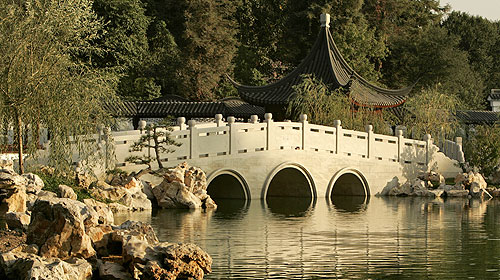
It brings back good memories just looking at it!Artisans Re-create a Classical Chinese Oasis
Bettijane Levine
Los Angeles Times, November 22, 2007While giving thanks today for all that's near and dear, it might not hurt to offer gratitude for folks you may never meet: workmen from China who have toiled for six months in San Marino, applying skills passed down through generations and not taught at any schools.
Their creation — the Garden of Flowing Fragrance — is springing up like some fantasy film set at the Huntington Library, Art Collections, and Botanical Gardens. But it is authentic in all respects. Its design re-creates botanical havens built by scholars who were the social elite during the Ming Dynasty, when the art of classical gardens reached its zenith in the city of Suzhou. When the new garden opens in February, visitors will find handmade bricks, tiles and wood structures, all with elaborate decorative details, all crafted by artisans brought here by the Huntington because their skills are as ancient and rare as the garden design itself. Like its predecessors, the garden sits within undulating white walls, its 1½ -acre lake dotted with hand-carved stone bridges, swooping-roofed pavilions and pebbled paths.
To execute this art, pavers sift through little pails of stones, placing them one by one to form floral patterns that make up the meandering walkways and plazas. They work deftly, finding the right size and shape, gently hammering each into place with a mallet.
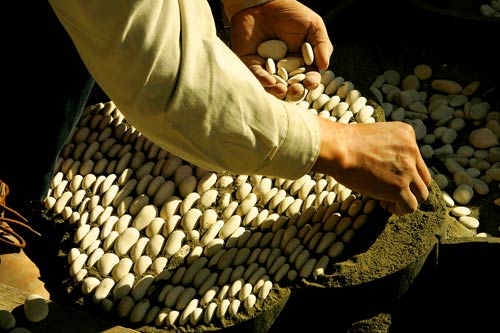
Annie Wells, Los Angeles Times
Stonemasons who specialize in calligraphy etch ancient characters into the spongy, hole-riddled limestone rock, 850 tons of which were imported from the Suzhou area. Not calligraphers themselves, these men are experts at transferring the masterful inscriptions of artists from paper onto stone. Each carving will tell visitors the name of the pavilion in which they're standing or will describe the poetry of the view.
The lake is encircled by massive chunks of rock, positioned there by specialists from Suzhou. These men also placed the 8-to-14-foot rocks that serve as sculptures, the kind of natural specimens valued in China since the Ming era for the grace and beauty of their shapes.
Woodwork specialists install the burnished panels of ginkgo and fir, carved or etched with patterns and classical themes passed down through centuries.
In the double-roofed, hexagonal Three Friends Pavilion, the ginkgo ceiling bears images of the three friends of winter — pine, bamboo and plum blossom — all of which remain hearty through the cold months. Wood carved into a traditional lattice-like pattern called "broken ice" is set like a delicate frozen curtain.
Tile specialists put finishing touches on pavilion roofs made exactly as they were 500 years ago. Clay is hand-fitted into molds and then fired with rice straw in brick kilns for at least 40 days. The resulting roof tiles are then placed — sideways instead of flat, and tightly overlapping — according to custom that has survived the ages. Every tile has been imprinted by hand with a chrysanthemum.
This is a moon gate, looking out on a walkway that follows feng shui principles. The zig-zags are designed to fool demons, who can only move in straight lines.
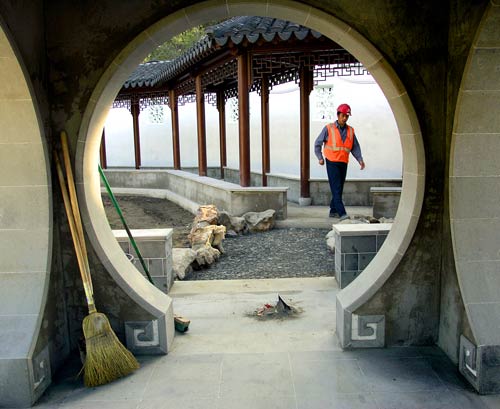
I'm especially fond of the mosaics which you can see being hammered into place, stone by stone, in the photo above. The result looks like this:
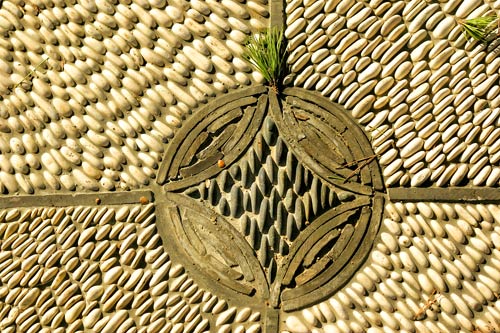
For comparison, here's some stonework I photographed in the Yu Yuan garden in Shanghai on August 4, 2006:
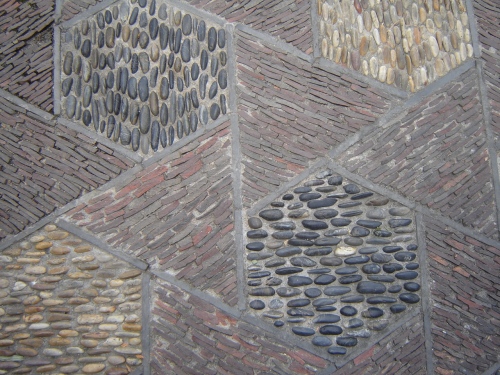
Today Chris Lee came over for Thanksgiving dinner: we had roast duck with olive sauce, sage dressing, sweet potatos and a nice bottle of wine. By the end of the night, he'd convinced me that I would have more fun and get more math done if I wrote fewer papers and relied more on my samizdat methods of spreading information: This Week's Finds, the n-Category Café, and videos. Indeed right now my main agony is the stack of papers I'm scheduled to write, which makes me feel guilty for spending time thinking about new ideas or talking with James Dolan. Maybe I should just tell some people sorry, I'm not going to write that paper.
Before Chris came, Lisa and I read some poems from Cid Corman's 2-volume magnum opus, Of. I'd read it once before and found it brilliant. This time, just quickly dipping in here and there, I was a bit disappointed. Maybe the effect is cumulative?
But there are certainly a bunch I like, including some that nicely
fit the "minimalist" theme of this month's diary:
had thought possible
suddenly occurred
and nothing happened.
You are here
to die and
that's what you
are doing.

Here Lisa caught it resting on the agave behind our house.
The first time we saw one of these, it was struggling to carry
a paralyzed tarantula to a safe location where it could lay its eggs
in the poor beast.
November 25, 2007
As you can tell, I've been thinking about minimalist art.
On the 14th I mentioned the Robert
Irwin show down in San Diego, which I plan to see over the winter
break. Today he was interviewed by the Los Angeles Times.
Here are a couple interesting things he said:
I like the honesty of admitting that "Modern art" is something that may or may not really work in the long term.On breaking the frame
"At one point, I looked around and I realized that there are no frames in the world. That's not how we see at all. We're like in an envelope, stuff happening on every dimension — visual, auditory, tactile, smell. Our dialogue with the frame is part of a highly stylized, learned logic. It's a way we've learned to see, but it's not how we actually see. In terms of how human beings see and understand and order the world for themselves, it seemed we had to address that. I had to paint a painting that broke the frame. That's what the disks were. Once you break the frame, all of a sudden you are in space. You're dealing with energy as opposed to matter. [The disks] really do get lost. They become light and space."On Modern art, abstraction and why the new isn't easy
"Most of our ideas are homogeneous. We maintain the basic structures, the basic ideas, the basic concepts. We build on them. But once in a while, something comes along that actually challenges those most basic assumptions. Modern art is doing that, or has done that. People used to ask abstractionists, 'What is it?' That's a literate question that says, 'Take this, in front of me, and let me understand it, not by participat ing in it directly, but by referencing it in the world.'"And [the abstractionists] would say, 'It is.' That's a whole different way of looking at the thing. It's not about something, it is something. When you make that kind of shift, it throws people off. It challenges the basic structures we've built. So people have a great degree of difficulty, because that's asking too much, in a way, to give up this structure and cut yourself loose, to float in this other realm. It's going to take a long time to see if we really want to play the game in this new realm.
"The history of Modern art, in my mind, is at least a couple hundred years old. It will be another couple hundred years before we're going to know if it works and what kind of idea it is. I pursue it because my questions feel right, they hold water and I like the beauty of it."
Have you heard about the world's biggest bug?
Technically it's a sea scorpion, or eurypterid. I loved such things (and had nightmares
about them) when I was a kid.
November 30, 2007
It's raining! Really raining, not just a drizzle.
You readers who don't live in the desert, who aren't suffering through
a long drought and fires, who don't have a garden,
may not know how exciting this is.

Here's a fun news story:
A rainy day is good for doing housecleaning. So, today I'll finally post links to some things Thomas Riepe has been telling me about for many months. I guess I'll concentrate on ecological news.
I've written about the Permian extinction elsewhere. Here's some news about it:
More on coral reefs:Approximately 250 million years ago, vast numbers of species disappeared from Earth. This mass-extinction event may hold clues to current global carbon cycle changes, according to Jonathan Payne, assistant professor of geological and environmental sciences. Payne, a paleobiologist who joined the Stanford faculty in 2005, studies the Permian-Triassic extinction and the following 4 million years of instability in the global carbon cycle. In the July issue of the Geological Society of America Bulletin, Payne presented evidence that a massive, rapid release of carbon may have triggered this extinction.
"People point to the fossil record as a place where we can learn about how our actions today may affect the future course of evolution," Payne said. "That's certainly true: The deep geologic record provides context for modern events. We may miss very important processes or underestimate the magnitude of changes in the future by using only the past couple thousand years as a baseline."
[...]
In 1991, scientists reported that the largest known volcanic event in the past 600 million years occurred at the same time as the end-Permian extinction. Magma extruded through coal-rich regions of the Earth's crust and blanketed a region the size of the continental United States with basalt to a depth of up to 6 kilometers. The eruptions that formed the Siberian Traps not only threw ash, debris and toxic gases into the atmosphere but also may have heated the coal and released vast quantities of carbon dioxide and methane into the atmosphere.
Rapid release of these greenhouse gases would have caused the oceans first to become acidic and then to become supersaturated with calcium carbonate. In the July Bulletin, Payne presents evidence that underwater limestone beds around the world eroded at the time of the end-Permian extinction. This finding, coupled with geochemical evidence for changes in the relative abundances of carbon isotopes, strongly suggests an acidic marine environment at the time of the extinction. The rock layers immediately covering this eroded surface include carbonate crystal fans, which indicate oceans supersaturated with calcium carbonate.
"This end-Permian extinction is beginning to look a whole lot like the world we live in right now," Payne said. "The good news, if there is good news, is that we have not yet released as much carbon into the atmosphere as would be hypothesized for the end-Permian extinction. Whether or not we get there depends largely on future policy decisions and what happens over the next couple of centuries."
[...]
Coral Reefs
Payne plans to learn more about the causes and consequences of this massive extinction event this summer. Three students left Aug. 1 to join him in southern China for four weeks of field studies.
If volcanic activity released sufficient quantities of carbon into the air within less than 100,000 years, the Earth would have transiently cooled and then experienced a prolonged period of global warming, Payne said. This summer, Ellen Schaal, a graduate student in the Department of Geological and Earth Sciences, will use one geochemical index to try to understand how climate did change during the end-Permian period.
Two other students will examine coral reef structures. The Great Bank of Guizhou contains the fossilized reefs from just before and just after this extinction event. Undergraduate Mindi Summers hopes to describe the ecological structure of coral reefs just before the extinction, and graduate student Brian Kelley will study the development and diversification of reefs after the global carbon cycle began to stabilize.
Reef communities are a sort of canary in the mineshaft, Payne explained. Today, coral reef health is considered a measure of environmental stability. When stressed by environmental conditions, the algae that inhabit the reef leave, and the reef loses color-and one reason why algae might leave is temperature. For example, when ocean temperatures rise during El Niño years, corals bleach. This type of immediate response to environmental change is hard to track in the geologic record.
The results of our analysis of 6001 quantitative reef surveys indicate that the degree, geographic extent, and duration of the Indo-Pacific coral decline have been significantly underestimated. Many coral reef scientists know of exceptions to the general pattern of reef degradation: there are currently many, perhaps hundreds or even thousands of high coral cover (i.e., >60%) reefs in the Indo-Pacific and Caribbean that resemble the presumed historical coral baseline. But our results indicate that such observations are anomalies and currently represent less than 2% of reefs in the Indo-Pacific. This study also highlights the urgent need for conservation policies to restore coral reefs and the ecosystem services they provide, estimated to be worth $23,100-$270,000 per square kilometer each year. Halting and reversing coral loss will require actions across a range of scales including local restoration and conservation of herbivores that facilitate coral recruitment and the reduction of fishing practices that directly kill corals, the implementation of regional land use practices that reduce sedimentation and nutrient pollution, and the institution of global policies to reduce anthropogenic ocean warming and acidification.See my August 1, 2006 entry for more on the state of our oceans, coral bleaching, and the like.
From water, let's move on to dirt:
Dirt, soil, call it what you want — it's everywhere we go. It is the root of our existence, supporting our feet, our farms, our cities. This fascinating yet disquieting book finds, however, that we are running out of dirt, and it's no laughing matter. An engaging natural and cultural history of soil that sweeps from ancient civilizations to modern times, Dirt: The Erosion of Civilizations explores the compelling idea that we are — and have long been — using up Earth's soil. Once bare of protective vegetation and exposed to wind and rain, cultivated soils erode bit by bit, slowly enough to be ignored in a single lifetime but fast enough over centuries to limit the lifespan of civilizations. A rich mix of history, archaeology and geology, Dirt traces the role of soil use and abuse in the history of Mesopotamia, Ancient Greece, the Roman Empire, China, European colonialism, Central America, and the American push westward. We see how soil has shaped us and we have shaped soil — as society after society has risen, prospered, and plowed through a natural endowment of fertile dirt. David R. Montgomery sees in the recent rise of organic and no-till farming the hope for a new agricultural revolution that might help us avoid the fate of previous civilizations.As you probably know, a lot of Iraq is desert. This wasn't true several thousand years ago: it's the result of human activity. Here's a little tale about that, by Rania Masri:
The first procurement and subsequent deforestation originates from the site where civilization first emerged, the Fertile Crescent. I would like to share with you an episode from the Epic of Gilgamesh known as the Forest Journey. Through this story lies the understanding of ecological processes and the consequences of human action.Approximately 4700 years ago in Uruk, a city-kingdom in southern Mesopotamia, Uruk's ruler Gilgamesh sought to ensure his immortality through the material greatness of his city. He wanted large amounts of timber to accomplish his plans, and he set his sight on the cedars of Lebanon. Extending before Gilgamesh lay an area of land so large its exact size was not known. An almost unbroken forest flourished near southern Mesopotamia, in the hills and mountains surrounding the Fertile Crescent. The forest was so dense that the suns light barely penetrated through its foliage.
The chief Sumerian deity Enlil protected these glorious forests by entrusting the ferocious demigod Humbaba to protect the interests of nature against the desires of civilization. Enlil understood the unlimited appetite of civilization, and predicted that once humans would enter the fo rest, they would remove all the gods beautiful garden of trees; they would destroy the divine beauty where the cedars raise aloft their luxuriance.
After a moment of enjoying the glory and awe of the magnificent, virgin cedar forest, Gilgamesh and his lumberjack companions began destroying the "abode of the gods". They cut the cedars, chopped their branches and trunks into transportable sizes. A fight erupted between the intruders and the mighty forest demigod... the greed of civilization won; the forest's guardian lost his head; and the cedars wailed with fear now that Gilgamesh was master of the forest. The trees were correct to cry, for the men stripped the mountains of their cover, leaving bare rock. When Enlil, who forever must watch over the well-being of the earth, learned of the destruction of the cedar forest, he sent down a series of ecological curses on the offenders: May the food you eat be eaten by fire; may the water you drink be drunk by fire.
So ended the tale, lamenting the soon-to-be sorry state of southern Mesopotamia...and the many other civilizations bent on destroying their forests.
The direction we're moving in seems almost hopeless sometimes. But, people are really starting to take global warming and other massive changes seriously — even the relatively benighted citizens of the USA. In 2006, California passed the Global Warming Solutions Act, which requires that greenhouse gas emissions be reduced to 1990 levels by 2020, and to 80% below this level by 2050. The California Air Resources Board just figured out how much greenhouse gases were actually emitted in 2006 — a small first step, but a mammoth calculation in its own right. The answer: the equivalent of 427 million metric tons of carbon dioxide!
And there are a lot of good people trying to get us out of the mess we're making. For example, Thomas Riepe pointed me towards the website of Graciela Chichilnisky. Her first paper was on pure math: group actions on spin manifolds, to be precise. But, she quickly moved on to more useful things, like the mathematics of sustainable development, the impact of the "knowledge revolution", and the meaning of property rights in a human-dominated Earth. She's now a professor of economics and statistics at Columbia University. She's just one of many...
So, I wouldn't say things are hopeless. It's a complex struggle with a highly uncertain outcome.
© 2007 John Baez
baez@math.removethis.ucr.andthis.edu